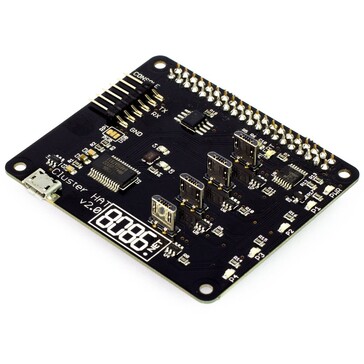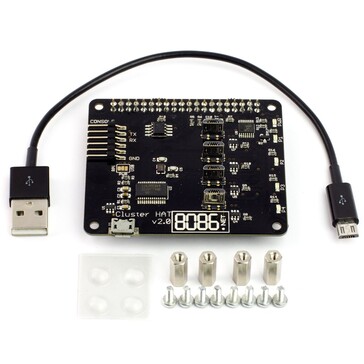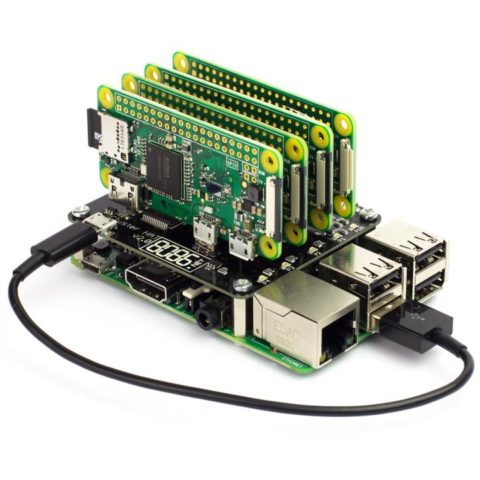Cluster HAT is a solution to the problem of building cluster computing. Distributed computing is difficult already, and this tiny hardware kit is one answer to the problem.
Although building a computer cluster is not that easy, it is one of the most impressive Raspberry Pi projects.
Why Cluster HAT?
The Cluster HAT (Hardware Attached on Top) interfaces a (Controller) Raspberry Pi A+/B+/2/3/4 with 4 Raspberry Pi Zeros. It is configured to use USB Gadget mode. Also, it is an ideal tool for teaching, testing or simulating small scale clusters.
Cluster HAT leverages the flexibility of Raspberry Pi by allowing programmers to experiment with cluster computing.

It is important you know that the HAT does not come with a Raspberry Pi or Pi Zero. The two are purchased separately. Pimoroni, the manufacturer, provides assembly and control instructions on its product page. Also, they explain 3 ways of setting up the HAT.
Specifications of Cluster HAT
- The HAT can be used with any mix of Pi Zero 1.2, Pi Zero 1.3 and Pi Zero W.
- USB Gadget Mode: Ethernet and Serial Console.
- Onboard 4 port USB 2.0 hub.
- Raspberry Pi Zeros powered via Controller Pi GPIO (USB optional).
- Individual Raspberry Pi Zero power controlled via Controller Pi GPIO (I2C).
- Connector for Controller Serial Console (FTDI Basic).
- Controller Pi can be rebooted without interrupting power to Pi Zeros (network recovers on boot).
 Kit includes:
Kit includes:
- The HAT
- HAT standoffs and screws
- Short USB rope (color may vary)
In Conclusion
The cluster HAT v2.3 is available for purchase, and while it is currently out of stock at Pimoroni, it is available to order from SB-Components for $49.22.

Via NotebookCheck

Tiwalade Joanna Okedara is a content writer, and blogger, with a passion for all things tech. She also specialises in writing SEO content, and spends most of her time researching new content marketing strategies. She loves to cook, and plan events in her spare time
Support CNX Software! Donate via cryptocurrencies, become a Patron on Patreon, or purchase goods on Amazon or Aliexpress. We also use affiliate links in articles to earn commissions if you make a purchase after clicking on those links.




> Cluster HAT is a solution to the problem of building cluster computing.
IMO no, I even doubt that this product is that useful to learn cluster computing in a reasonable way. Also directly after launch of the RPi 4 citing product descriptions mentioning
> Controller Pi can be rebooted without interrupting power to Pi Zeros (network recovers on boot).
is IMO problematic. And the setup instructions mention neither 3B+ nor 4B as being ‘compatible’ and outlines the fundamental thermal design flaw of all recent B Raspberries: ‘please be aware the Raspberry Pi 3 may reduce the CPU speed when hot which may happen with high CPU usage with or without a HAT’ — you can either get those cool or use a HAT.
I think I’ve seen this before somewhere.. I think it was called a usb hub or something.
I would tend to agree with tkaiser however:
You can use an extra 40-pin f-m ribbon cable to not have the hat on top of the Pi host or to use much taller stand-offs and keep the heat-sink and/or fan on the Pi host CPU or a side fan to cool the whole apparatus.
Overall it looks like a $250 solution for five discrete CPUs to play with. Never underestimate what kiddies from 7 to 77 can come up with, especially when they start to use it for something it was not intended to.
This being said, if you already have the network, the cables, etc with $250 you can get 5 Pi 3 or 4 with power supply, so this offering is not that transcendent. So no is indeed the right answer.
What people seem to overlook: the above is more than just an USB2 hub since you can power cycle each Zero via an I2C accessible controller which is a real benefit when playing around with clustering (a node disappears — what now?).
But you can test the very same in any virtualized environment too and there you also can play around with (virtualized) networking and test what happens if a (virtualized) switch goes down or even more important starts to misbehave and so on…
It’s not worth $50 for what is essentially a usb hub and some mosfets. IIRC there are USB hubs out there with per-port power control that would allow you to do the same thing via USB (quick google: https://github.com/mvp/uhubctl).
Either way it doesn’t let you see what happens when a node gets kicked off of the cluster and comes back warm which IMHO is a lot more interesting than it rebooting and joining the cluster again with a clean slate.
Side note: If there really is a market for micro clusters a board the size of this HAT with 4 or more Cortex A7 SoCs with 64 or 128mb of memory should be possible based on some IP camera SoCs. I think such a board not already existing is a symptom of things like this being a solution in search of a problem.
> it doesn’t let you see what happens when a node gets kicked off of the cluster and comes back warm which IMHO is a lot more interesting than it rebooting
Exactly. With a (virtualized) switch where you can disable/enable ports it’s really funny to test for such behavior. Also duplicate MAC addresses and such stuff. Playing with a cluster that is based on g_ether networking (USB gadget mode) prevents testing for the real stuff 🙂
BTW: For power control with some selected SBC not even a hub in between is been needed. To power cycle the left USB port an on Olimex A20 Lime2 for example this is all that’s needed:
(ok, this Olimex A20 board has only 3 USB ports that are switchable that way, right USB port is
PH03and Mini USBPC17)If you virtualise the switch you should get access to traffic shaping too so you can simulate random packet loss and so on. Other than telling your friends you have a cluster I really don’t get products like this.
MPI and Beowulf clusters are traditional high-performance applications for devices like this.
There’s also OpenMOSIX.
> https://github.com/mvp/uhubctl
Thanks for this. Works flawlessly with both my Apple display and keyboard! 🙂
I want some backplane like that for powering a cluster of B3+ easily using only a single cable